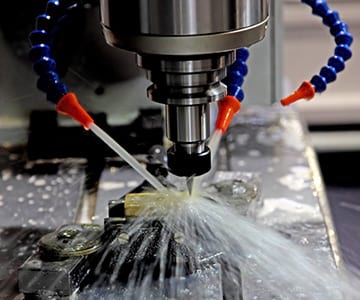Understanding the CNC Milling Process
 Computer numerical control (CNC) milling is responsible for revolutionizing the machine shop, granting the ability to mass produce detailed components faster and with more accuracy than traditional methods. Once a CNC machine is programmed and set, operators can produce more pieces at faster speeds with good part-to-part repeatability, making the process ideal for high-volume manufacturing.
Computer numerical control (CNC) milling is responsible for revolutionizing the machine shop, granting the ability to mass produce detailed components faster and with more accuracy than traditional methods. Once a CNC machine is programmed and set, operators can produce more pieces at faster speeds with good part-to-part repeatability, making the process ideal for high-volume manufacturing.
The CNC milling machine combines the accuracy of computerized controls to rotate and position multi-point cutting tools. As the raw stock progresses through the pre-programmed machining operation, a tool moves along the three primary axes, X, Y, and Z to precisely cut away material. For intricate and complex geometries, a 5-axis CNC milling machine will move along three linear axes while simultaneously moving along two rotational axes.
MF Engineering is an expert in CNC milling as well as other CNC machining services, and we can help you choose the right material and methods for your production run. This blog post will focus on CNC milling capabilities and the common materials used with this process.
CNC Milling Methods
CNC milling is a subtractive form of manufacturing, which means that material is removed from the workpiece to produce the final design shape. The process starts with a computer-aided design (CAD) drawing or 3D model of the final component. That dimensional data is then exported into a language that computer-aided manufacturing (CAM) software can understand. The CNC milling machine reads the generated CAM instructions and conducts a series of precise machine movements along different paths and axes.
Here are the most common CNC milling methods:
- Plain milling. Also known as surface milling, this milling process uses a cutting tool to remove material along the surface of the workpiece. In plain milling, the rotation axis is parallel to the workpiece.
- Face milling. Face milling uses a rotational axis perpendicular to the material’s surface. The cutting or grinding tool faces down against the workpiece surface to remove material.
- Angular milling. This milling method positions the cutting tool’s rotary axis at an angle to the workpiece surface to produce angular cuts as specified by the design, such as grooves or dovetails.
- Form milling. Form milling makes non-flat cuts, such as contours, curves, and radii. Each type of curve will require a specific cutting tool to create an accurate form cut.
Types of CNC Milling Machines
CNC milling machines are highly versatile and may be used to facilitate a variety of cuts and machining operations. In general, however, the workpiece remains stationary while the cutting tool moves and rotates to remove material and realize the design. Different CNC milling machines will have varying spindle configurations that hold and move the workpiece in different ways.
- Horizontal Milling: A spindle with a mounted cutting tool is oriented horizontally as it presses against the workpiece. Horizontal milling can handle deeper and heavier cuts using thicker and shorter cutting tools.
- Vertical milling: A vertically-oriented spindle moves a rotating cutting tool up and down to remove material from a stationary workpiece. The turret-style milling machine features a spindle and table that moves both perpendicular and parallel to the axis.
- Multi-axis milling: 4-axis and 5-axis CNC mills facilitate highly detailed or complex machine operations. Multi-axis milling machines move on the X, Y, and Z axes, in addition to rotating on the A and B axes. This allows the workpiece to be approached from any direction, often facilitating multiple operations simultaneously.
CNC Milling Applications
The benefits of CNC milling include its ability to cut a wide range of materials and produce custom-designed parts much faster than conventional machining. CNC milling can be used to machine parts from a variety of materials, such as:
Metals
- Aluminum
- Beryllium
- Brass
- Bronze alloys
- Carbon steel
- Copper
- Iron
- Nickel
- Stainless steel
- Steel alloys
- Titanium
Exotic and Precious Metals
- Inconel
- Monel
- Platinum
- Silver
- Superalloys
Plastics
- ABS
- Acetal
- Acrylic
- Fiber-reinforced plastics
- Nylon
- Phenolic
- Polycarbonate
- Polyetherketone
- PTFE
- PVC
- Teflon
CNC milling can be used with any industry that requires precise components, including complex industries such as aerospace and military. No matter what your component geometry or material, MF Engineering offers the right CNC milling process to meet your needs. To learn more about our capabilities, please contact us or request a quote.

